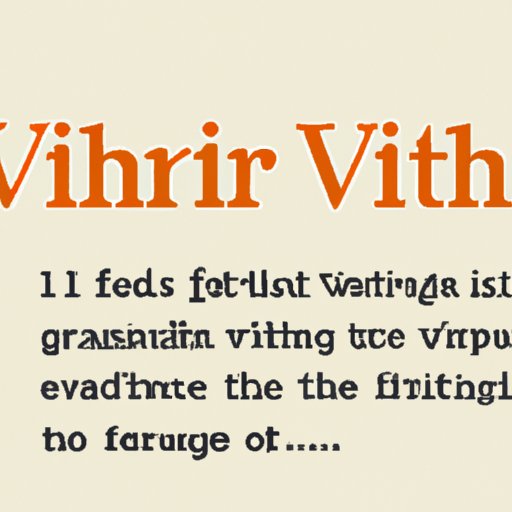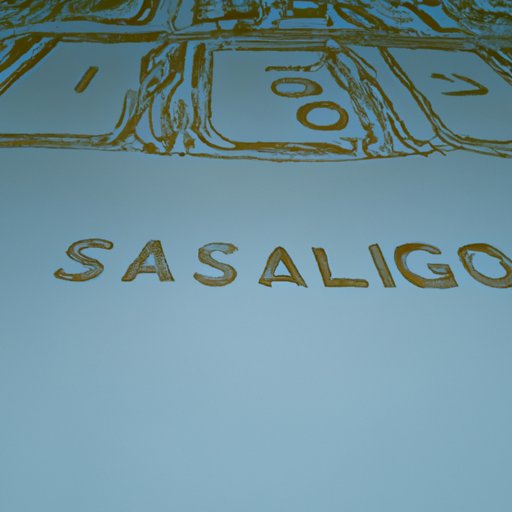I. Introduction
Have you ever read a book and come across a quote before the first chapter begins? That, my friend, is an epigraph. Epigraphs are often overlooked in the literary world, but they are an essential part of literary works. Understanding the use of epigraphs can add an exciting dimension to your reading experience and writing craft. In this article, we will explore what an epigraph is, its importance in literature, and how it adds depth to literary works.
II. Exploring the Use of Epigraphs in Novels and Poetry
A. The origin of epigraphs in literature
Epigraphs have been around for thousands of years, with their use dating back to ancient Greek literature. The word “epigraph” comes from the Greek word “epigraphein” which means “to inscribe upon.” In ancient times, epigraphs were inscriptions that were carved into stone or metal. They were used to commemorate an event or person and often contained a quote or verse.
B. Examples of novels and poetry with epigraphs
Epigraphs can be found in both novels and poetry. One well-known example is F. Scott Fitzgerald’s “The Great Gatsby,” which begins with a quote from Thomas Parke D’Invilliers. Another example is Mary Shelley’s “Frankenstein,” which starts with a quote from John Milton’s “Paradise Lost.” In poetry, T.S. Eliot’s “The Waste Land” begins with a quote from the Satyricon by Petronius.
C. Importance of epigraphs in setting the tone
Epigraphs set the tone for the literary work that follows. They provide context, insight, and commentary on what is to come. They can introduce themes, hint at symbols, and prepare readers for what is about to unfold. In “The Great Gatsby,” the epigraph foreshadows the themes of the novel and establishes the idea of the past influencing the present. In “Frankenstein,” the epigraph introduces the idea of creation and the dangers of playing God.
III. Epigraphs: A Literary Device that Adds Depth to Literary Works
A. Detailed explanation of how epigraphs add depth to literary works
Epigraphs add depth to literary works by providing additional layers of meaning. They can offer insights into the author’s intentions and the themes of the work. Epigraphs allow authors to draw connections to other works, cultures, or historical events that shape the meaning of their work. By using an epigraph, authors can also create a dialogue between the quoted text and their own work, inviting readers to explore the connections between them.
B. Analysis of examples of epigraphs in different literary works
One example of how epigraphs can add depth can be found in Margaret Atwood’s “The Handmaid’s Tale.” The novel begins with a quote from Genesis: “And when Rachel saw that she bare Jacob no children, Rachel envied her sister, and said unto Jacob, Give me children, or else I die.” This epigraph foreshadows the novel’s central theme of fertility and the role of women in reproduction. The quote establishes biblical allusions, which are woven throughout the novel and highlight the religious undertones of the dystopian society.
C. Importance of using epigraphs in literary works
Epigraphs are a powerful tool that can add depth and layers of meaning to literary works. They can provide context, hint at themes, and foreshadow symbols. Epigraphs can also create a dialogue between works, cultures, or historical events. Most importantly, epigraphs can set the tone for the work that follows and prepare readers for what is to come.
IV. Examining the Different Types of Epigraphs in Literature
A. Definition of different types of epigraphs
Epigraphs can take on different forms and serve different purposes. One type is the literary epigraph, which is a quote from a literary work that connects the author’s work with another work of literature. Another type is the historical epigraph, which quotes an historical document, such as a letter or diary entry, to provide context for the work. The cultural epigraph is another type, which quotes from a cultural artifact, such as a song or poem, to highlight its significance.
B. Explanation of how different types of epigraphs are used in literature
Depending on the type of epigraph used, authors can highlight different aspects of their work. A literary epigraph can create connections to other works of literature, emphasizing the work’s place in the literary canon. A historical epigraph can provide context for social or historical events, which may not be familiar to readers. The cultural epigraph draws attention to cultural traditions that are important to the author or the work’s subject matter.
C. Analysis of examples of different types of epigraphs
An example of a literary epigraph can be found in Salman Rushdie’s “Midnight’s Children.” The novel includes a quote from Gabriel Garcia Marquez’s “One Hundred Years of Solitude.” The literary epigraph connects Rushdie’s work to the magical realism literary genre, highlighting the novel’s fantastical elements. A historical epigraph can be found in Harper Lee’s “To Kill a Mockingbird,” where the novel begins with a quote from Charles Lamb’s “Essays of Elia,” which references the social inequality and injustice that are explored in the story. Cultural epigraphs can be found in Alice Walker’s “The Color Purple,” where the novel begins with a quote from “The Book of Isaiah,” which relates to the themes of oppression and redemption that dominate the book.
V. Understanding the Purpose of Epigraphs in Contemporary Literature
A. Explanation of how epigraphs are used in contemporary literature
Epigraphs continue to be used in contemporary literature, with many authors using them as a way to engage with literary history and cultural traditions. Authors use epigraphs to establish the tone of their writing, set the reader’s expectations, or provide the context necessary to understand the work.
B. Analysis of examples of epigraphs in contemporary literature
A poignant example comes from Colson Whitehead’s “The Underground Railroad,” which begins with a quote from William Still’s “The Underground Rail Road Records.” This historical epigraph provides context for the novel’s main subject, slavery and escape, while also highlighting the author’s engagement with history and the connections he draws between the past and present.
C. Importance of using epigraphs in contemporary literature
Epigraphs continue to play an essential role in contemporary literature. They are useful for setting the tone, providing context, and creating a dialogue between the author’s work and literary traditions, cultural artifacts, and historical events.

VI. The Art of Crafting Epigraphs in Fiction Writing
A. Explanation of how to craft an effective epigraph
When crafting an epigraph, authors should consider the purpose of the work and the effect they wish to create. They should choose a quote or reference that establishes a connection between the epigraph and the work, perhaps by the use of parallelism or irony. Authors should also consider the tone they wish the epigraph to set for their work.
B. Guidelines for using epigraphs in writing
Epigraphs work best when they are brief yet meaningful additions to the work. They should not be used to replace development within the narrative or contradict the themes explored in the work. The quote or reference used should be appropriate for the genre, tone, and subject matter of the work.
C. Tips for crafting epigraphs
When crafting an epigraph, it is important to experiment with different options to find the best one to complement the work. Researching other works that explore similar themes or subject matter can provide a good foundation to select a viable reference. Using a personal quote or reference can also offer more personal meaning for the writer.
VII. The Evolution of Epigraphs: From Ancient Literature to Modern Fiction
A. Historical evolution of epigraphs in literature
Epigraphs have evolved over time from inscriptions on monuments to literary devices used to add depth to literary works. As literature and other art-forms have evolved, so have the devices used to communicate within and across them.
B. Examples of how epigraphs have evolved over time
Epigraphs have evolved from a solely historical or religious context, to include an array of literary devices and can be used to create additional context to that of the work itself. Epigraphs are used differently, nevertheless, the power of the epigraph and its ability to create depth and resonance with the reader remains consistent.
C. Insight into the future of epigraphs in literature
It’s hard to say what the future of epigraphs holds. The literary world is constantly changing, and new devices are being explored and developed. Nevertheless, despite the rise of digital literature, the tradition of using epigraphs in literature has not dwindled, in fact, they remain a key feature of many works and are likely to continue to be.”
VIII. Conclusion
In conclusion, epigraphs remain a sophisticated literary device that can add depth and meaning to literary works. Understanding the use of epigraphs can add another dimension to one’s reading experience, allowing for deeper appreciation and comprehension of a work’s meaning. Epigraphs can serve many purposes and take on various forms, complementing and enhancing each literary work in its unique way. Finally, taking time to skillfully craft an epigraph can make the difference between an ordinary work and a truly remarkable one.
So, the next time you pick up a work of literature, pay attention to its epigraph. It might just offer a fresh perspective you haven’t considered before.
(Note: Is this article not meeting your expectations? Do you have knowledge or insights to share? Unlock new opportunities and expand your reach by joining our authors team. Click Registration to join us and share your expertise with our readers.)
